Top Rankings
Lancaster Independent School District ranks among the top 20% of public school district in Texas for:
Category
Attribute
Graduation Rate
Highest graduation rate (Top 5%)
Community Size
Largest student body (number of students) (Top 1%)
For the 2025 school year, there are 8 public elementary schools serving 3,733 students in Lancaster Independent School District. This district's average elementary testing ranking is 3/10, which is in the bottom 50% of public elementary schools in Texas.
Public Elementary Schools in Lancaster Independent School District have an average math proficiency score of 32% (versus the Texas public elementary school average of 42%), and reading proficiency score of 41% (versus the 52% statewide average).
Minority enrollment is 99% of the student body (majority Black), which is more than the Texas public elementary school average of 75% (majority Hispanic).
Overview
This School District
This State (TX)
# Schools
10 Schools
6,902 Schools
# Students
7,014 Students
3,737,053 Students
# Teachers
410 Teachers
255,471 Teachers
Student : Teacher Ratio
17:1
17:1
District Rank
Lancaster Independent School District, which is ranked #969 of all 1,196 school districts in Texas (based off of combined math and reading proficiency testing data) for the 2021-2022 school year.
The school district's graduation rate of 98% has stayed relatively flat over five school years.
Overall District Rank
#979 out of 1204 school districts
(Bottom 50%)
(Bottom 50%)
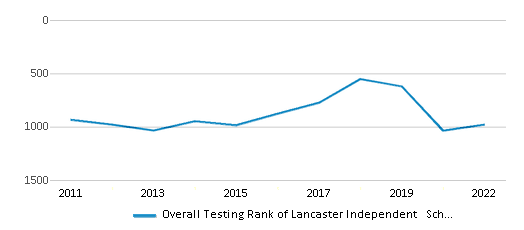
Math Test Scores (% Proficient)
27%
41%
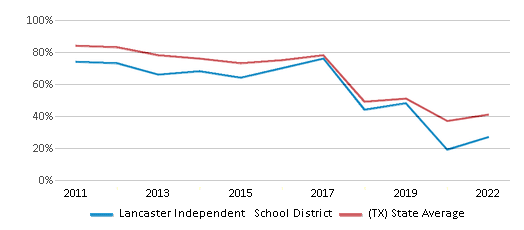
Reading/Language Arts Test Scores (% Proficient)
40%
51%
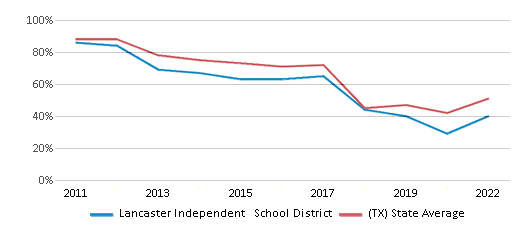
Science Test Scores (% Proficient)
30%
46%
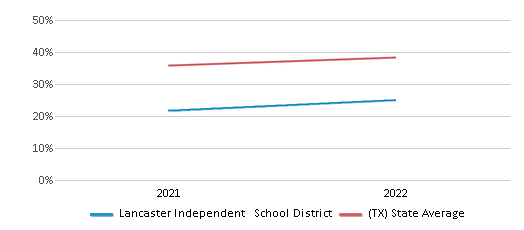
Graduation Rate
98%
90%
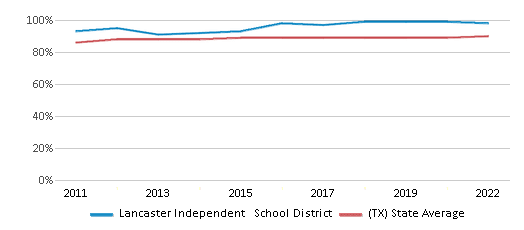
Students by Ethnicity:
Diversity Score
0.43
0.64
# American Indian Students
32 Students
11,705 Students
% American Indian Students
1%
n/a
# Asian Students
17 Students
203,767 Students
% Asian Students
n/a
6%
# Hispanic Students
1,652 Students
1,997,454 Students
% Hispanic Students
24%
53%
# Black Students
5,053 Students
469,194 Students
% Black Students
72%
13%
# White Students
85 Students
924,841 Students
% White Students
1%
25%
# Hawaiian Students
8 Students
5,879 Students
% Hawaiian Students
n/a
n/a
# Two or more races Students
167 Students
124,213 Students
% of Two or more races Students
2%
3%
Students by Grade:
# Students in PK Grade:
563
222,501
# Students in K Grade:
382
346,866
# Students in 1st Grade:
475
385,427
# Students in 2nd Grade:
472
402,148
# Students in 3rd Grade:
476
399,623
# Students in 4th Grade:
436
398,690
# Students in 5th Grade:
503
399,071
# Students in 6th Grade:
426
402,143
# Students in 7th Grade:
463
335,034
# Students in 8th Grade:
505
339,814
# Students in 9th Grade:
572
32,833
# Students in 10th Grade:
615
28,116
# Students in 11th Grade:
592
23,862
# Students in 12th Grade:
534
20,925
# Ungraded Students:
-
-
District Revenue and Spending
The revenue/student of $14,081 is higher than the state median of $13,387. The school district revenue/student has stayed relatively flat over four school years.
The school district's spending/student of $11,524 is less than the state median of $14,116. The school district spending/student has stayed relatively flat over four school years.
Total Revenue
$99 MM
$74,029 MM

Spending
$81 MM
$78,063 MM
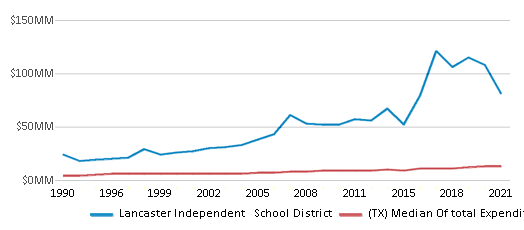
Revenue / Student
$14,081
$13,387
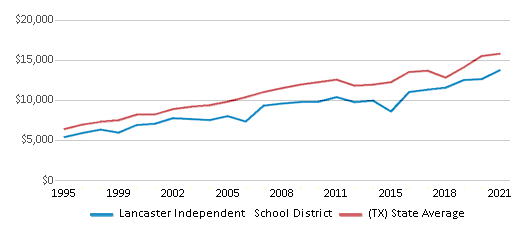
Spending / Student
$11,524
$14,116
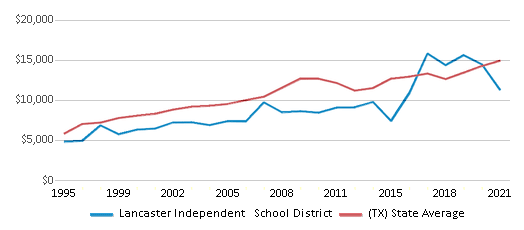
Best Lancaster Independent School District Public Elementary Schools (2025)
School
(Math and Reading Proficiency)
(Math and Reading Proficiency)
Location
Grades
Students
Rank: #11.
Belt Line Elementary School
(Math: 45-49% | Reading: 55-59%)
Rank:
Rank:
8/
Top 30%10
1355 W Belt Line Rd
Lancaster, TX 75146
(972) 218-1608
Lancaster, TX 75146
(972) 218-1608
Grades: PK-5
| 522 students
Rank: #22.
West Main Elementary School
(Math: 42% | Reading: 51%)
Rank:
Rank:
6/
Top 50%10
531 W Main St
Lancaster, TX 75146
(972) 218-1551
Lancaster, TX 75146
(972) 218-1551
Grades: PK-5
| 608 students
Rank: #33.
Rosa Parks/millbrook Elementary School
(Math: 30-34% | Reading: 50-54%)
Rank:
Rank:
5/
Bottom 50%10
630 Millbrook Dr
Lancaster, TX 75146
(972) 218-1564
Lancaster, TX 75146
(972) 218-1564
Grades: PK-5
| 441 students
Rank: #44.
Houston Elementary School
(Math: 40% | Reading: 39%)
Rank:
Rank:
4/
Bottom 50%10
2929 Marquis St
Lancaster, TX 75134
(972) 218-1512
Lancaster, TX 75134
(972) 218-1512
Grades: PK-5
| 708 students
Rank: #55.
Rolling Hills Elementary School
(Math: 25-29% | Reading: 45-49%)
Rank:
Rank:
4/
Bottom 50%10
450 Rolling Hills Pl
Lancaster, TX 75146
(972) 218-1525
Lancaster, TX 75146
(972) 218-1525
Grades: PK-5
| 428 students
Rank: #66.
G W Carver 6th Grade Stem Learning Center
(Math: 27% | Reading: 29%)
Rank:
Rank:
2/
Bottom 50%10
1005 Westridge
Lancaster, TX 75146
(972) 218-1577
Lancaster, TX 75146
(972) 218-1577
Grades: 6
| 426 students
Rank: #77.
Pleasant Run Elementary School
(Math: 17% | Reading: 37%)
Rank:
Rank:
2/
Bottom 50%10
427 W Pleasant Run Rd
Lancaster, TX 75134
(972) 218-1538
Lancaster, TX 75134
(972) 218-1538
Grades: PK-5
| 600 students
Rank: n/an/a
Jd Hall Learning Center
Alternative School
602 E Second St
Lancaster, TX 75146
(972) 218-1441
Lancaster, TX 75146
(972) 218-1441
Grades: 1-12
| n/a students
Recent Articles

Sexual Harassment at Age 6: The Tale of a First Grade Suspension
A six-year old in Aurora, Colorado, was suspended after singing an LMFAO song to a little girl in his class and reportedly “shaking his booty.” We look at the case and the sexual harassment problem in public schools today.

How Scaffolding Could Change the Way Your Child Learns
This article explores the concept of instructional scaffolding, a teaching method that enhances learning by breaking down complex tasks into manageable parts. It highlights how scaffolding supports students in developing critical thinking skills and becoming more independent learners. The article discusses the benefits of scaffolding, including improved engagement and reduced anxiety, and provides strategies for its implementation across various educational levels.

February 05, 2025
Understanding the U.S. Department of Education: Structure, Impact, and EvolutionWe explore how the Department of Education shapes American education, from its cabinet-level leadership to its impact on millions of students, written for general audiences seeking clarity on this vital institution.





